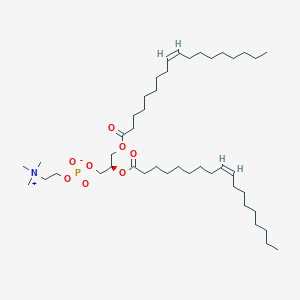| Synonyms |
Click to Show/Hide Synonyms of This Metabolite
(R-(Z,Z))-(7-Oleoyl-4-oxido-10-oxo-3,5,9-trioxa-4-phosphaheptacos-18-enyl)trimethylammonium 4-oxide; 1,2-DOCPC; 1,2-Di-(9Z)-octadecenoyl-sn-glycero-3-phosphocholine; 1,2-Di-(9Z-octadecenoyl)-sn-glycero-3-phosphocholine; 1,2-Dioleoyl glycerophosphocholine; 1,2-Dioleoyl-3-sn-phosphatidylcholine; 1,2-Dioleoyl-GPC; 1,2-Dioleoyl-L-alpha-lecithin; 1,2-Dioleoyl-sn-glycero-3-phosphochline; 1,2-Dioleoyl-sn-glycero-3-phosphocholine; 1,2-Dioleoyl-sn-glycero-3-phosphorylcholine; 1,2-Dioleoyl-sn-glycero-phosphatidylcholine; 1,2-Dioleoyl-sn-glycerol-3-ethylphosphocholine; 1,2-Dioleoyl-sn-phosphatidylcholine; 1,2-Dioleoylglycerol-3-phosphorylcholine; 1,2-Dioleoylglycerophosphocholine; 1,2-Dioleoylglyceryl-3-phosphorylcholine; 1,2-Dioleoyllecithin; 1,2-Dioleoylphosphatidylcholine; 1,2-Dioleyl-L-lecithin; 1,2-Oleoyl-sn-glycero-3-phosphocholine; 1,2-Oleoylphosphatidylcholine; 1,2-Oleoylphosphatidylcholine, (L-alpha)-(R-(Z,Z))-isomer; 1-(9Z)-Octadecenoyl-2-(9Z)-octadecenoyl-sn-glycero-3-phosphocholine; 1-C18:1(Omega-9)-2-C18:1(omega-9)-phosphatidylcholine; DOPC; Dielaidinoyl lecithin; Dielaidoylphosphatidylcholine; Dioleoyl lecithin; Dioleoyl phosphatidylcholine; Dioleoyl-3-sn-phosphatidylcholine; Dioleoyl-L-alpha-glycerophosphocholine; Dioleoyl-L-alpha-glycerophosphorylcholine; Dioleoylglycerophosphocholine; Dioleoylglycerophosphorylcholine; Dioleoylglycerylphosphorylcholine; Dioleoyllecithin; Dioleoylphosphatidylcholine; Dioleyl lecithin; Dioleyl phosphatidylcholine; Dioleylphosphatidylcholine; GPC(18:1(9Z)/18:1(9Z)); GPC(18:1/18:1); GPC(18:1n9/18:1n9); GPC(18:1w9/18:1w9); GPC(36:2); GPCho(18:1(9Z)/18:1(9Z)); GPCho(18:1/18:1); GPCho(18:1n9/18:1n9); GPCho(18:1w9/18:1w9); GPCho(36:2); L-Dioleoyl lecithin; L-Dioleoylphosphatidylcholine; L-alpha-Di(cis-9-octadecanoyl) lecithin; L-alpha-Dioleoyl phosphatidylcholine; L-alpha-Dioleoyllecithin; PC 18:1; PC(18:1(9Z)/18:1(9Z)); PC(18:1/18:1); PC(18:1n9/18:1n9); PC(18:1w9/18:1w9); PC(36:2); Phosphatidylcholine 18:1; Phosphatidylcholine(18:1(9Z)/18:1(9Z)); Phosphatidylcholine(18:1/18:1); Phosphatidylcholine(18:1n9/18:1n9); Phosphatidylcholine(18:1w9/18:1w9); Phosphatidylcholine(36:2); sn-3-Dioleoyllecithin
|
 click to show the details of this protein
click to show the details of this protein
 click to show the details of experiment for validating this pair
click to show the details of experiment for validating this pair

